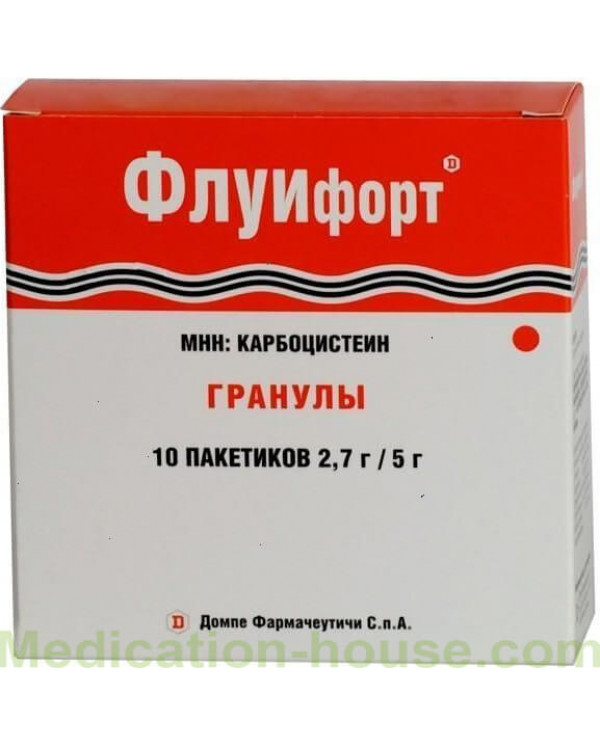Instruction for Fluifort
Reed more and buy Fluifort on this page
Promotes regeneration of the mucous membrane, normalizes its structure, activates the activity of the ciliary epithelium. Restores the secretion of immunologically active IgA (specific protection) and the number of sulfhydryl groups of mucus components (non-specific protection), improves mucociliary clearance.
Composition
Carbocysteine lysine salt monohydrate + excipients.
Pharmacokinetics
Quickly and completely absorbed after oral administration. Cmax in blood and secretion is achieved within the first hour after administration. The therapeutic concentration remains in the blood for 8 hours. It is excreted mainly in the urine, about 30-60% - unchanged, the rest - in the form of metabolites.
Indications
Acute and chronic bronchopulmonary diseases, accompanied by the formation of viscous and difficult to separate sputum, including:
tracheitis;
bronchitis;
tracheobronchitis;
bronchial asthma;
bronchiectatic disease.
Inflammatory diseases of the middle ear and paranasal sinuses, accompanied by the formation of viscous and difficult to separate mucus, including:
rhinitis;
adenoiditis;
otitis media;
sinusitis.
Preparing the patient for bronchoscopy and bronchography.
Release Forms
Granules for the preparation of a suspension for oral administration in 5 g sachets (sometimes mistakenly called a powder).
Instructions for use and method of use
The drug is taken orally.
Adults are prescribed 1 sachet per day. The contents of the bag before taking should be dissolved in water and mixed.
The duration of treatment is determined by the doctor (from 4 days to 6 months).
Side effect
epigastric pain;
nausea;
diarrhea;
skin rash.
All of these side effects are transient in nature and disappear after stopping the drug or after reducing the dose.
If any side effect occurs, the patient should consult a doctor.
Contraindications
peptic ulcer of the stomach and duodenum in the acute phase;
children's age up to 1 year (for syrup);
children's and teenage age up to 16 years (for granules);
1 trimester of pregnancy;
lactation period;
phenylketonuria;
hypersensitivity to the components of the drug.
Pregnancy and lactation
The drug is contraindicated for use in the 1st trimester of pregnancy and during lactation.
Use in children
The drug in the form of syrup is contraindicated in children under 1 year old. The drug in the form of granules is contraindicated in children and adolescents under the age of 16 years.
Special instructions
From the first days of taking Fluifort, an expectorant effect is enhanced due to improved secretion.
The use of Fluifort does not lead to the development of addiction or metabolic dependence.
Fluifort treatment can be combined with physiotherapeutic procedures.
With caution, you should use the drug with a history of gastric ulcer and duodenal ulcer in the anamnesis, in the 2nd and 3rd trimesters of pregnancy.
The granular Fluifort contains aspartame, which is contraindicated in patients with phenylketonuria.
Fluifort syrup contains sucrose. This should be considered for patients on a low-calorie diet, as well as for patients with diabetes. 1 tablespoon of syrup contains 5.25 g of sucrose, 1 teaspoon of syrup contains 3.5 g of sucrose.
Drug interaction
With the simultaneous use of Fluifort with antitussive agents and m-anticholinergic drugs, its effect may decrease.
With simultaneous use, it increases the effectiveness of glucocorticosteroids (GCS) (mutually) and antibiotics, enhances the bronchodilator effect of theophylline.
No interaction between Fluifort and food, as well as substances used for laboratory research.
Terms of sell
You don't need a prescription to buy Fluifort.


